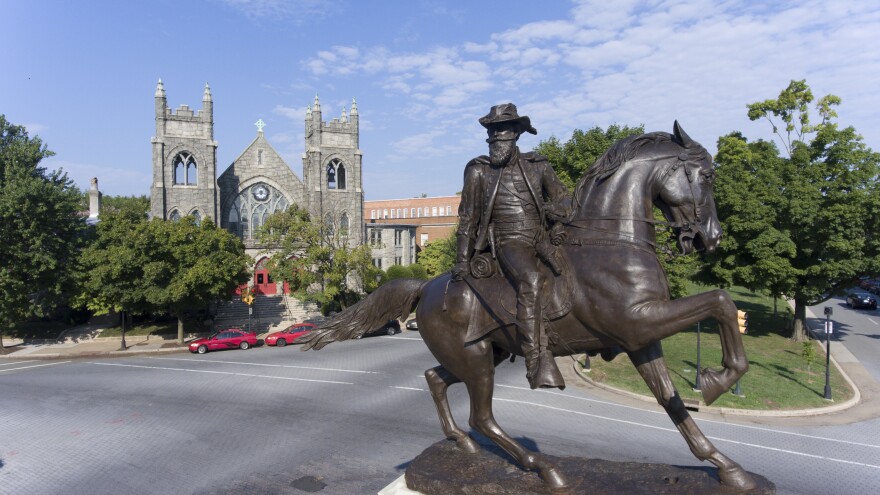Updated Wednesday 5:43 p.m. ET
"They're designed to terrorize and menace."
That's how artist Kehinde Wiley describes towering monuments to Confederate leaders that stand in the middle of Richmond, the capital of the Confederacy. One statue depicts cavalry commander Gen. J.E.B. Stuart sitting upon a muscular horse, striking a heroic pose.
About a mile away, a similar bronze sculpture has been installed; but instead of a Confederate general, it portrays a black man with dreads, wearing a hoodie and Nikes.
The statue called Rumors of War was built by Wiley, widely known for painting the official portrait of President Barack Obama. After spending several weeks on display in Times Square, the three-story-tall statue was officially unveiled Tuesday at its permanent home in front of the Virginia Museum of Fine Arts.
"It is monumental and not just a figure of speech, it is truly monumental, in terms of its ability to be a seismic shift in how we perceive and how we understand ourselves as people living here," Valerie Cassel Oliver, the museum's curator of modern and contemporary art, told NPR.
The museum wrote that the new sculpture "commemorates African American youth lost to the social and political battles being waged throughout our nation."

Richmond has a long history of coming to terms with its Confederate past. In an attempt to tell a more comprehensive story, officials have authorized several changes, including renaming a school and some streets.
Several Confederate statues still stand near the city center. After visiting Richmond and seeing them, Wiley saw an opportunity to position black people on the same monumental scale.
"It allows you to see someone who's oftentimes relegated to the periphery is elevated to the status of an icon, to the scale of a God," Wiley told NPR's Bilal Qureshi.
Hundreds of people attended the official unveiling, which included remarks by Gov. Ralph Northam and Richmond Mayor Levar Stoney. The event had one problem — when the drape was pulled off the statue, it caught on the dreadlocks and covered the face of the young black rider.
Although the complete viewing was delayed, Wiley said it elevated the experience.
"We've waited a long time for this moment, and by this thing being slowed down and heightened, it only made that sense of time much more precious and prescient," Wiley said.

Julian Hayter, a historian and associate professor at the University of Richmond, sees Wiley's installation as a way to push back against narratives about the Confederacy that minimize or deny the role of slavery and racism in the Civil War.
"Many of the institutions that are springing up and the ideas and the artistry that's, in some ways, emerging to replace this imagery is a direct response to the methodology of the Lost Cause, and it's gained particular momentum in the last several years with the rise of white supremacy in the 21st century," Hayter told NPR.
Richmond is just one of many communities contemplating its relationship with Confederate monuments. Earlier this year, a Virginia judge blocked efforts to take down a Charlottesville statue of Robert E. Lee. Some officials, barred from removing monuments, are instead choosing to add plaques alongside the statues that discuss the historical context of their subjects.
In 2018, protesters tore down a Confederate monument known as Silent Sam at the University of North Carolina at Chapel Hill. Activists' celebrations turned into outrage when they found out the university was paying the state chapter of the Sons of the Confederate Veterans $2.5 million to preserve it.
Paolo Zialcita is an intern on NPR's News Desk.
Copyright 2021 NPR. To see more, visit https://www.npr.org.


